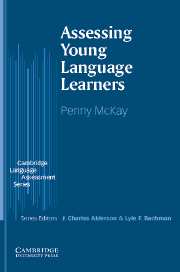Book contents
- Frontmatter
- Contents
- Series editors' preface
- Acknowledgments
- 1 A special case for young learner language assessment
- 2 Young learners and language learning
- 3 Research into the assessment of young language learners
- 4 Assessing language use through tasks
- 5 Classroom assessment of language use
- 6 Assessing oral language
- 7 Assessing reading and writing
- 8 Evaluating young learners' performance and progress
- 9 Testing young language learners through large-scale tests
- 10 The way forward
- References
- Index
- Publishers' acknowledgments
8 - Evaluating young learners' performance and progress
Published online by Cambridge University Press: 04 May 2010
- Frontmatter
- Contents
- Series editors' preface
- Acknowledgments
- 1 A special case for young learner language assessment
- 2 Young learners and language learning
- 3 Research into the assessment of young language learners
- 4 Assessing language use through tasks
- 5 Classroom assessment of language use
- 6 Assessing oral language
- 7 Assessing reading and writing
- 8 Evaluating young learners' performance and progress
- 9 Testing young language learners through large-scale tests
- 10 The way forward
- References
- Index
- Publishers' acknowledgments
Summary
Introduction
This chapter is concerned with the phase of assessment in which teachers and assessors evaluate the quality of children's performance in language use tasks. How do teachers and assessors of young learners know what to look for in children's performance? How do they establish the qualities of a good performance? What scoring methods do they use to guide their judgment about quality? And how do they do this in ways that make sure that the decisions that we make as a result of the assessment are as ‘useful’ as is required?
In this chapter I discuss the characteristics of good scoring rubrics, with examples of common types of rubrics that can be used in young learner language assessment. Scoring rubrics are the instructions for marking or scoring that are prepared for and by teachers and assessors. There are ways that scoring rubrics can be constructed to maximize their potential for effective scoring. Finally, in this chapter, some examples of standards are given and discussed, since standards are used more and more commonly to evaluate young learners' performance and progress over time.
A note on evaluating performance during classroom formative assessment
The kinds of assessment decisions classroom teachers make about children's performance are often embedded in the busy-ness of teaching and are mainly aimed at improving learning. Some commentators suggest that there are qualitative differences between the decisions that teachers make to evaluate performance in this kind of assessment, compared to decisions made by teachers and assessors to evaluate performance in more formal assessment tasks.
- Type
- Chapter
- Information
- Assessing Young Language Learners , pp. 264 - 314Publisher: Cambridge University PressPrint publication year: 2005



